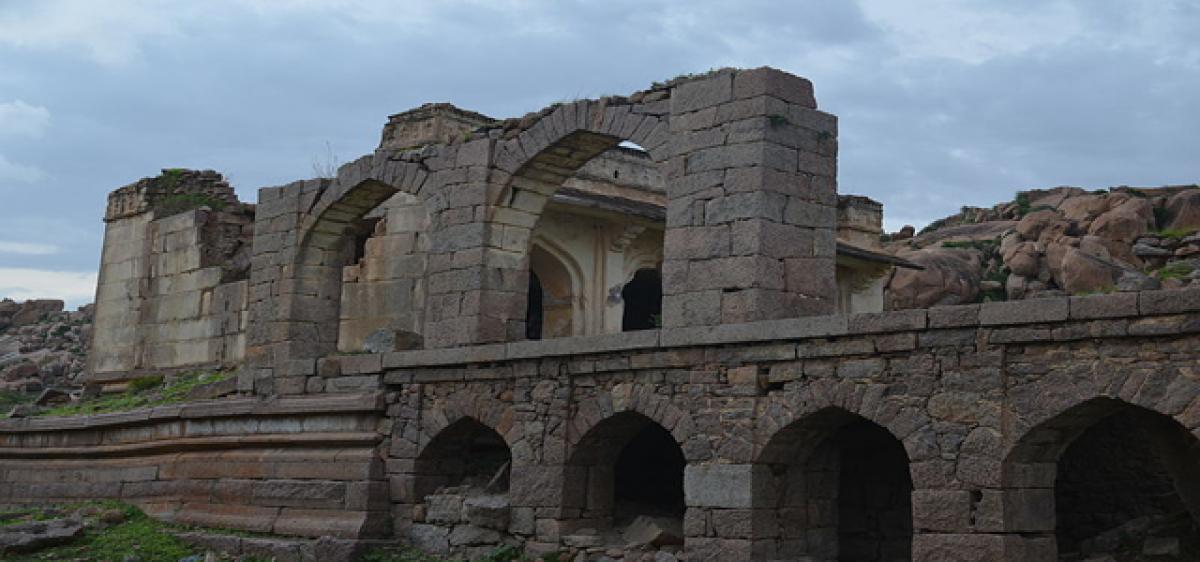Live
- AI can boost early diagnosis of liver disease: Study
- Varun's appointment as AHUDA chief infused new vigour in JSP cadres
- Lokayukta, HRC will remain in Kurnool: Minister Bharath
- S Korea, US, Japan unveil secretariat establishment, slam N Korea-Russia on Ukraine war expansion
- Light to Moderate Rains Expected in Telangana and Andhra Pradesh
- Pilgrims throng Sabarimala temple on opening day of long festive season
- Jwala Thoranam held at Srisailam temple
- Birsa Munda Jayanti celebrated
- Another tigress released in soft enclosure in Similipal
- Coastal defence exercise on Nov 20-21
Just In

Historical forts in Gooty, Rayadurg and Penukonda are glaring examples of neglect as the heritage structures represent the pristine glory of the once powerful Vijayanagar empire.
Penukonda (Anantapur): Historical forts in Gooty, Rayadurg and Penukonda are glaring examples of neglect as the heritage structures represent the pristine glory of the once powerful Vijayanagar empire. These historical structures which tell the tales of the once powerful empire are unfortunately not part of the tourism circuit and despite many promises by the government to develop the places and bring them on to the tourist map of AP, the historical places were totally neglected.
Penukonda, the historical town and second capital of the Vijayanagar empire during the time of Sri Krishnadevaraya in 15th century has lost its sheen. It is crying for attention as the entire town is an archaeological treasure trove and many monuments need to be protected. The ghosts of the emperors, who ruled the Vijayanagar empire, will be baffled to see their once second capital utterly in ruins and more than 300 of its 365 temples missing and erased from its geography.
Rulers be it the erstwhile Congress government and the present TDP government had been promising to restore the pristine glory of the historical town, but it is more said than done. A few historical monuments like the grand entrance to the fort and exit walls, temples of Lord Rama and Shiva and Babaiah Darga stands today as mute spectators of a bygone era.
The town is known for its host of Hindu temples, Muslim Darga and Jain temples. The ancient town was ruled by Hoysalas, Chalukyas, Vijayanagar kings, Nawabs, Marathas, Tipu Sultan, Nizams and eventually came under British rule after it was ceded to the British by the Nizam of Hyderabad. It was a melting pot of different religions, but the town and fort were established by early Hoysala kings, who were practitioners of Jainism.
Because of its ancient Jain history and presence of many temples, it is one of the most revered places for Jains. The famous Pache Parsvanath Swamy Temple, with idol of Parsvanath containing a single green coloured stone (Pacha) is located here. According to the various inscriptions found inside the Penukonda fort, the Penukonda state was gifted by the King Bukka-I to his son Virupanna Udaiyar and constructed by the later.
The tough and deep involvement in architectural planning of the fort still seem as the ruins are the story teller of that period. This fort was the toughest wall against any type of intrusion. It is also believed that a water supply system was also there to bring water from the lake nearby for the population residing inside the fort.
This fort was also used as a cooling and relaxing place for the royal family members of Vijayanagar Empire. According to an inscription on the main portion of this fort, it was built in 1575 AD. This fort also has a basement which was constructed in traditional Hindu style of construction. But exterior of the fort has a mixed stamp of architecture.
Hampi, located in this fort has the Islamic shade of architecture but other portions also have the incarnations and edges like temples. One of the major portions of this fort is ‘Babaiah Darga’ and this building is still symbolising the communal harmony between Hindus and Muslims at that time.
By Ravi P Benjamin

© 2024 Hyderabad Media House Limited/The Hans India. All rights reserved. Powered by hocalwire.com







